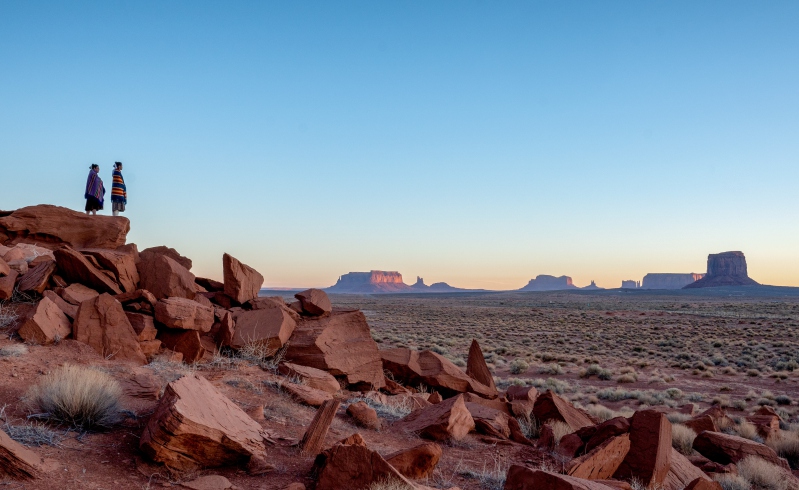
Scholars argue religious liberty laws should stop the federal government from destroying Native sacred sites.
Like the Sistine Chapel, the Western Wall, and the Kaaba, Oak Flat is a sacred site. To the Western Apache, Oak Flat—a “6.7-square-mile traditional cultural property” east of Phoenix—is “the buffer between heaven and earth.” They have used Oak Flat to pray, conduct religious ceremonies, and gather sacred plants and spring waters “since time immemorial.”
Despite the land’s central role in Apache religion, the federal government has asserted ownership over Oak Flat for nearly 150 years. Earlier this year, the government finalized plans to transfer the site to two of the world’s largest mining companies for copper extraction.
Native groups have challenged the transfer in court, arguing that constructing a two-mile-wide, thousand-foot-deep mining pit on their sacred site would violate their religious rights. The district court rejected their claim, but the Biden Administration has at least temporarily halted the transfer.
Oak Flat may be safe for now, but the site’s near destruction demonstrates that otherwise robust U.S. religious liberty laws can drastically fail to protect Native sacred sites, according to two law professors, Michalyn Steele of Brigham Young University and Stephanie Hall Barclay of University of Notre Dame.
In a recent article, Steele and Barclay conclude that these laws fall short because courts underestimate the burden that the government can impose on Native religions. They argue that federal control of Native sacred sites creates a baseline of governmental interference in Native religious exercise. They contend that if courts take that interference into account, religious liberty laws will more readily and justly protect Native sacred sites.
Native religions are distinctively “land based,” Steele and Barclay explain. Because the United States dispossessed Native people of their ancestral homelands, the federal government now controls many sacred sites. This ownership dynamic often makes Native people “beholden to government to continue to engage in centuries-old practices and ceremonies,” Steele and Barclay observe.
The federal government’s dual roles as land manager and gatekeeper to sacred sites can come into conflict when federal development policy threatens Native religious sites, as happened at Oak Flat. Native people argue that these kinds of development plans run afoul of U.S. religious liberty laws.
Religious liberty laws generally prohibit governmental conduct that substantially burdens religious exercise. In practice, the laws typically regulate governmental actions that involve coercion, such as threatening penalties or loss of benefits for religious exercise. When Native people have sought protection under these laws, however, courts have largely found that the desecration, degradation, or destruction of Native sacred sites does not constitute a substantial burden.
For instance, in a 2008 case, Native Nations challenged a U.S. Forest Service plan to spread artificial snow made of treated sewage water over their sacred mountain sites. The U.S. Court of Appeals for the Ninth Circuit held that the policy did not substantially burden the Native Nations’ religious exercise. Although the recycled wastewater would harm the Native Nation’s “subjective spiritual experience,” the court reasoned, it was not a substantial burden because it did not coerce the Native Nations “to act contrary to their religious beliefs under the threat of sanctions” or lost government benefits.
Steele and Barclay argue that courts such as the Ninth Circuit have incorrectly analyzed the government coercion involved in these cases. Native people whose religious exercise depends on access to federally managed sacred sites “are subjected to a baseline of omnipresent government interference with their religious exercise,” according to Steele and Barclay. Courts can more accurately assess burdens on religious exercise by taking that baseline into account.
In similar circumstances elsewhere, courts require the government “to lift its coercive power through a religious accommodation,” Steele and Barclay explain. In carceral settings, for example, religious liberty laws require the government to provide accommodations for religious grooming and dietary practices as well as access to worship services and religious leaders. In these settings—as with Native religious exercise, Steele and Barclay emphasize—courts find burdens on religious exercise when the government simply denies requests for religious accommodations, regardless of threatened penalties.
Courts analyzing Native people’s religious freedom claims should consider baseline government interference, Steele and Barclay conclude. They urge the courts to adopt a substantial burden test that examines whether the government has “substantially interfered with a religious individual’s ability to voluntarily act on his or her theological commitments,” whether that interference is direct or indirect. Steele and Barclay anticipate that courts using this test will readily find a substantial burden where the federal government makes Native religious worship impossible by destroying or degrading a sacred site.
Although U.S. law generally promises strong protection for religious exercise, it has largely failed to protect Native religious sites, argue Steele and Barclay. Recently, the U.S. Supreme Court has revisited protections for religious freedom through Fulton v. City of Philadelphia and multiple decisions halting COVID-related restrictions on religious worship. As the Court reinvigorates its religious freedom doctrine and some justices signal support for reexamining and replacing the Court’s standards for assessing burdens on religious exercise, Steele and Barclay map a path to include Native religions and rectify what they characterize as the “egregious double standards in the law” that have left Native people behind for too long.



